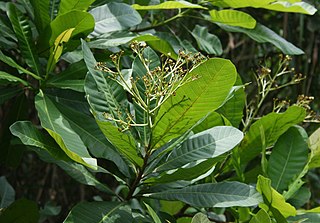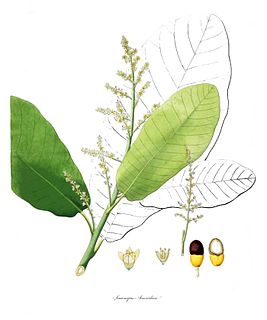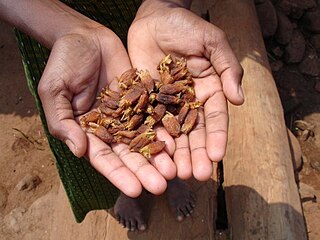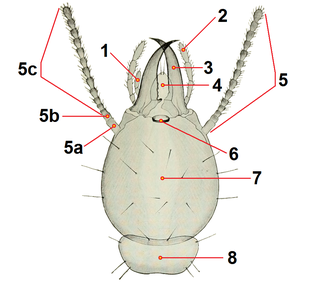
The cashew tree is a tropical evergreen tree that produces the cashew seed and the cashew apple pseudofruit. The tree can grow as high as 14 m (46 ft), but the dwarf cultivars, growing up to 6 m (20 ft), prove more profitable, with earlier maturity and greater yields.

The Anacardiaceae, commonly known as the cashew family or sumac family, are a family of flowering plants, including about 83 genera with about 860 known species. Members of the Anacardiaceae bear fruits that are drupes and in some cases produce urushiol, an irritant. The Anacardiaceae include numerous genera, several of which are economically important, notably cashew, mango, poison ivy, poison oak, sumac, smoke tree, marula, yellow mombin, Peruvian pepper and cuachalalate. The genus Pistacia is now included, but was previously placed in its own family, the Pistaciaceae.

Anacardium, the cashews, are a genus of flowering plants in the family Anacardiaceae, native to tropical regions of the Americas.

Gracillariidae is an important family of insects in the order Lepidoptera and the principal family of leaf miners that includes several economic, horticultural or recently invasive pest species such as the horse-chestnut leaf miner, Cameraria ohridella.

Anacardium excelsum, the wild cashew or espavé, is a tree in the flowering plant family Anacardiaceae. The tree is common in the tropical and subtropical dry broadleaf forests of Pacific and Atlantic watersheds of Central and South America, extending as far north as Guatemala and south into Ecuador.

Madhuca longifolia is an Indian tropical tree found largely in the central and north Indian plains and forests. It is commonly known as madhūka, madkam, mahuwa, mahua, mahwa, mohulo, or Iluppai or vippa chettu. It is a fast-growing tree that grows to approximately 20 meters in height, possesses evergreen or semi-evergreen foliage, and belongs to the family Sapotaceae. It is adaptable to arid environments, being a prominent tree in tropical mixed deciduous forests in India in the states of Odisha, Chhattisgarh, Jharkhand, Uttar Pradesh, Bihar, Maharashtra, Telangana, Madhya Pradesh, Kerala, Gujarat, West Bengal and Tamil Nadu.

Semecarpus anacardium, commonly known as the marking nut tree, phobi nut tree and varnish tree, is a native of India, found in the outer Himalayas to the Coromandel Coast. It is closely related to the cashew.

Madhuca is a genus of plants in the family Sapotaceae first described as a genus in 1791.

Sources: Common Trees of India, Pippa Mukherjee, World Wildlife Fund India/ Oxford University Press 1983, Flowering Trees and Shrubs in India, D.V. Cowen
Caloptilia protiella is a moth of the family Gracillariidae. It is known from China, India, Java, Japan, Malaysia and Thailand.
Eteoryctis syngramma is a moth of the family Gracillariidae. It is known from Hong Kong, India, Indonesia and Thailand.
Acrocercops euthycolona is a moth of the family Gracillariidae, known from Maharashtra, India, as well as Brunei Darussalam, Indonesia, Malaysia, the Solomon Islands, Sri Lanka, and Vanuatu. It was described by Edward Meyrick in 1931.
Acrocercops phaeospora is a moth of the family Gracillariidae, known from Karnataka, India. It was described by Edward Meyrick in 1916. The hostplants for the species include Vigna mungo, Vigna unguiculata, Cleistocalyx operculatus, Eugenia cumini, Eugenia jambolana, Syzygium littorale, Madhuca latifolia, and Theobroma cacao.
Acrocercops phaeomorpha is a moth of the family Gracillariidae, known from Maharashtra, Gujarat, and Bihar, India. It was described by Edward Meyrick in 1919. The hostplant for the species is Madhuca indica, and Madhuca latifolia.
Gautala Autramghat Sanctuary is a protected area of Maharashtra state, India. It lies in the Satmala and Ajantha hill ranges of the Western Ghats, and administratively is in Aurangabad District and Jalgaon District. The wildlife sanctuary was established in 1986 in an existing reserved forest area.

Anacardium humile, a plant species from the genus Anacardium and the family Anacardiaceae, is known for its medicinal and insecticidal properties. The shrub is commonly found in the Brazilian Pantanal and Cerrado.
Madhuca curtisii is a tree in the family Sapotaceae.
Madhuca korthalsii is a tree in the family Sapotaceae. It is named for the Dutch botanist P. W. Korthals.
Madhuca motleyana is a tree in the family Sapotaceae. It is named for engineer and naturalist James Motley, who lived and worked in Borneo in the 1850s.

Coptotermes ceylonicus, is a species of subterranean termite of the genus Coptotermes. It is native to India and Sri Lanka. It is a common wood destroying termites, which damage to logs, woodens structures of both natural and man-made. It is a pest of many economically valuable trees such as Hevea brasiliensis and Camellia sinensis, and also an inhabitant of Anacardium occidentale, Cocos nucifera, Ficus fergusonii, Gliricidia sepium, Grevillea robusta, Madhuca longifolia, Tamarindus indica and Theobroma cacao.










